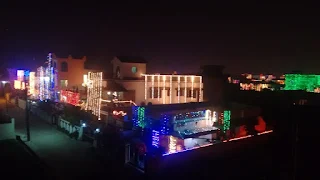Anne-Sophie, French, 25 and freshly land off to start my internship in the Branding department at
Chandigarh University, India. Graduating from a Master in Intercultural and International Communication, I choose to come to India to embrace the cultural diversity and innovation technology that India offers to a young westerner that I am. First time in India, there were no better time to arrive than during the most important Indian holidays, Diwali.
Freshly land off
to start my internship in India that Diwali holidays are about to start. Even
though I had never heard about Diwali, I could read the excitement on people’s
face; going home for this 5 days holiday was all they were talking about. I
listen, do some research about that Diwali people talk about and even
fortunately, get invited to spend the holiday in my co-worker’s family in
Dehradun, a medium Indian city – medium scaled in India equivalent to a large
scaled city in Europe. After all, “we are 1.2 billion people here”.
At first, I thought Diwali was a
holy holiday, comparable to Christmas or Easter holidays in Western countries,
where family would gather and celebrate for dinner on Diwali day. I was as
close and as far from the real meaning of this holiday to Indians. Diwali, also
called Deepavali, is the most important religious celebration in India, and
even among Indian diasporas all around the world.
During this celebration, clay
lamps are lightened in and out homes in order to allow the inner light to
protect them from spiritual darkness. Originally a Hindu harvest festival, the
celebration extended to businesses and to all Indian communities, regardless of
their religion. There are different interpretations of Diwali according to the
religion and the regions, but it all come out to the victory of good over evil.
In northern India, where I celebrated my Diwali, the Hindu community celebrates
the return of Rama to Ayodhya. King Ravana, after stealing Rama’s wife,
banished him. It is after 14 years of exile that Rama came back to defeat
Ravana. To celebrate his triumph, the residents of Ayodhya lightened rows
(avali) of clay lamps (deepa).
The family I celebrated Diwali with
is a Nepalese family. However, they are celebrating Diwali as any other
families. I have been welcomed in the most generous way and took part of the
celebration as their own. We started arraying clay lamps around the house and
hang some flowers. Then we draw the traditional rangoli by the doorstep with
coloured sand. On Diwali day, the whole family gathered at a house where
Nepalese artists danced and sang to worship Lord Ganesha and Goddess Lakshmi.
While playing with firecrackers and fireworks, family and friends come and go
from house to house to feast and celebrate.
Even though in my Western culture we celebrate
holy holidays with family gatherings and feasts, the Indian way of celebrating
is different and reminded me the true notion of sharing. Diwali is beyond
sitting for a dinner, it is 5 days of food sharing, family gatherings, friends
visit and shares of stories. This cultural experience is a good reminder that
sharing does not have to be seen as a materialistic way to satisfy others but
should simply remain as simple as spending time together, regardless of your
religion, beliefs and culture.







